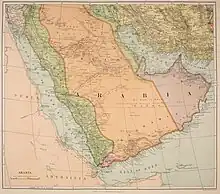List of royal families on the Arabian Peninsula in the 20th century
This is a list of royal families on the Arabian Peninsula[lower-alpha 1] in the 20th century.
- Bahrain (independent since 1971): House of Khalifa (Al Khalifah).[2]
- Hejaz (1916–1925): Hashemites (Al Hashim).[lower-alpha 2]
- Idrisid Emirate of Asir (1908–1934): Idrisid dynasty.[3]
- Jabal Shammar (1836–1921): House of Rashīd (Rasheed, Rashidi): historical Arabian dynasty ruling Hail, northern Nejd.[4]
- Kuwait: House of Sabah (Al Sabah).[2]
- Oman: House of Busaid (Al Bu Said).[5]
- Saudi Arabia: House of Saud (Al Saud).[2]
- Qatar (independent since 1971): House of Thani (Al Thani),[2] originally bedouin from Nejd.[6]
- House of Al-Daweesh the ruling branch of the Mutayr tribe ruled Najd for a time
- United Arab Emirates (Trucial States until 1971[lower-alpha 3]) – royal families:
- Abu Dhabi: House of Nahyan (Al Nahyan).
- Ajman: House of Nuaimi (Al Nuaimi).
- Dubai: House of Maktoum (Al Maktoum).
- Fujairah: House of Sharqi (Al Sharqi).
- Ras Al Khaimah and Sharjah: House of Qasimi (Al Qasimi).
- Umm Al Quwain: House of Mualla (Al Mualla).
- Yemen:
- Federation of South Arabia (1962–1967): see "House" under "Federation of South Arabia § List of rulers". Abolished in 1967 and replaced by the People's Democratic Republic of Yemen (South Yemen; Aden).[8]
- Mutawakkilite Kingdom of Yemen (1918–1970): House of Rassid (al-Rassid), abolished in 1970 after being defeated by the Yemen Arab Republic (North Yemen, Sanaa) in the North Yemen Civil War (1962–1970).[9]

Map of Arabia, early 20th century (before 1909)
Notes
- 'The Arabian Peninsula currently includes the states of Saudi Arabia, Yemen, Oman, the United Arab Emirates, Qatar, Bahrain and Kuwait; under a strict delimitation, Jordan and Iraq are excluded from the peninsula'.[1]
- The Hashemites would go on to reign in the Kingdom of Iraq (1932–1958), in the Emirate of Transjordan (1921–1946), and since 1946 in the current Kingdom of Jordan. Under a strict delimitation, Iraq and Jordan are excluded from the Arabian Peninsula.[1]
- The seven sheikhdoms were known as the Trucial States under the British Raj's Persian Gulf Residency from 1820 to 1971. They became independent as the United Arab Emirates (UAE) in 1971.[7]
References
- "Arabisch Schierland". Encarta Encyclopedie Winkler Prins (in Dutch). Microsoft Corporation/Het Spectrum. 2002.
- Nyrop 1977, p. 230.
- Bang, Anne (1997). The Idrisi State in Asir 1906–1934. Hurst Publishers. pp. 87, 95–1004. Archived from the original on 9 December 2019. Retrieved 1 January 2021.
- "Ibn Sa'oed, Abd al-Aziz III ibn Abd al-Rahman". Encarta Encyclopedie Winkler Prins (in Dutch). Microsoft Corporation/Het Spectrum. 2002.
- Riphenburg 1998, p. 147.
- Nyrop 1977, p. 237.
- Nyrop 1977, p. 1.
- "Aden". Encarta Encyclopedie Winkler Prins (in Dutch). Microsoft Corporation/Het Spectrum. 2002.
- "Jemen". Encarta Encyclopedie Winkler Prins (in Dutch). Microsoft Corporation/Het Spectrum. 2002.
Bibliography
- Nyrop, Richard F. (1977). Area Handbook for the Persian Gulf States. Washington, D.C.: U.S. Government Printing Office. p. 448. Retrieved 27 June 2023.
These three royal families – Al Sabah of Kuwait, Al Saud of Saudi Arabia, and Al Khalifah of Bahrain – consider themselves the most important lineages on the Arabian Peninsula.
- Riphenburg, Carol J. (1998). "Changing Gender Relations and the Development Process in Oman". In Haddad, Yvonne Yazbeck; Esposito, John L. (eds.). Islam, Gender, & Social Change. Oxford: Oxford University Press. p. 259. ISBN 9780195113570. Retrieved 27 June 2023.
This article is issued from Wikipedia. The text is licensed under Creative Commons - Attribution - Sharealike. Additional terms may apply for the media files.